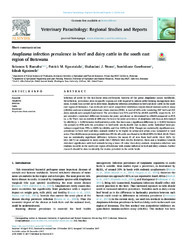| dc.contributor.author | Ramabu, Solomon S. | |
| dc.contributor.author | Kgwatalala, Patrick M. | |
| dc.contributor.author | Nsoso, Shaulani James | |
| dc.contributor.author | Gasebonwe, Sumbikane | |
| dc.contributor.author | Kgosiesele, Ednah | |
| dc.date.accessioned | 2020-07-07T09:01:45Z | |
| dc.date.accessioned | 2021-03-15T09:06:33Z | |
| dc.date.available | 2020-07-07T09:01:45Z | |
| dc.date.available | 2021-03-15T09:06:33Z | |
| dc.date.issued | 2017-12-26 | |
| dc.identifier.citation | Ramabu, S. S., Kgwatalala, P. M., Nsoso, S. J., Gasebonwe, S., & Kgosiesele, E. (2018). Anaplasma infection prevalence in beef and dairy cattle in the south east region of Botswana. Veterinary Parasitology: Regional Studies and Reports, 12, 4-8. | en_US |
| dc.identifier.issn | https://www.sciencedirect.com/science/article/pii/S2405939017300643 | |
| dc.identifier.uri | http://moodle.buan.ac.bw:80/handle/123456789/246 | |
| dc.description | 12 months Embargo | en_US |
| dc.description.abstract | Infection of cattle by the tick-borne intra-erythrocytic bacteria of the genusAnaplasmaoccurs worldwide.Nevertheless, prevalence rates in specific regions are still required to inform cattle farming management deci-sions. A study was carried out to determineAnaplasmainfection prevalence in beef and dairy cattle in the southeast region of Botswana. Two methods were used: competitive inhibition enzyme-linked immune-sorbent assay(cELISA) and conventional polymerase chain reaction (PCR). A total of 429 cattle consisting 207 beef and 222dairy animals were sampled and tested. The prevalence was 91% and 31% by cELISA and PCR, respectively. A Ztestrevealed a statistical difference between the point prevalence as determined by cELISA compared to PCR(p = 0). There was no statistical difference between the point prevalence ofAnaplasmainfection as determinedby cELISA (p = 0.45) between beef and dairy cattle. But there was a significant difference (p = 0.001) betweenthe animals by PCR with the prevalence in beef cattle nearly double that in dairy cattle. Individual herd pre-valence ranged from 79% to 100% by cELISA, and 0 to 100% by PCR. Though not statistically significant sero-prevalence in both beef and dairy animals tended to be higher in urban/peri-urban areas compared to ruralareas. The cELISA mean percentage inhibition (PI) for all cattle was found to be 58.6 (95% CI: 56.8–60.4). Therewas no statistically significant difference between the mean PI of sera from beef cattle (56.4 (95% CI:54.1–58.7)) as compared to dairy cattle (60.7 (95%CI: 58.0–63.3)). However, there was a tendency towardsstatistical significance with beef animals having a lower PI value than dairy animals.Anaplasmainfection wasendemic in cattle in the south east region of Botswana with similar infection in beef and dairy animals. Furtherresearch should be done to identify the strains prevalent in the cattle herds. | en_US |
| dc.description.sponsorship | BUAN | en_US |
| dc.language.iso | en | en_US |
| dc.publisher | Elsevier | en_US |
| dc.relation.ispartofseries | Veterinary Parasitology: Regional Studies and Reports;Vol. 12, 2018, 3-4 | |
| dc.subject | Anaplasma | en_US |
| dc.subject | Infection | en_US |
| dc.subject | Cattle | en_US |
| dc.subject | Prevalence | en_US |
| dc.subject | Polymerase chain reaction | en_US |
| dc.title | Anaplasmainfection prevalence in beef and dairy cattle in the south eastregion of Botswana | en_US |
| dc.type | Article | en_US |

